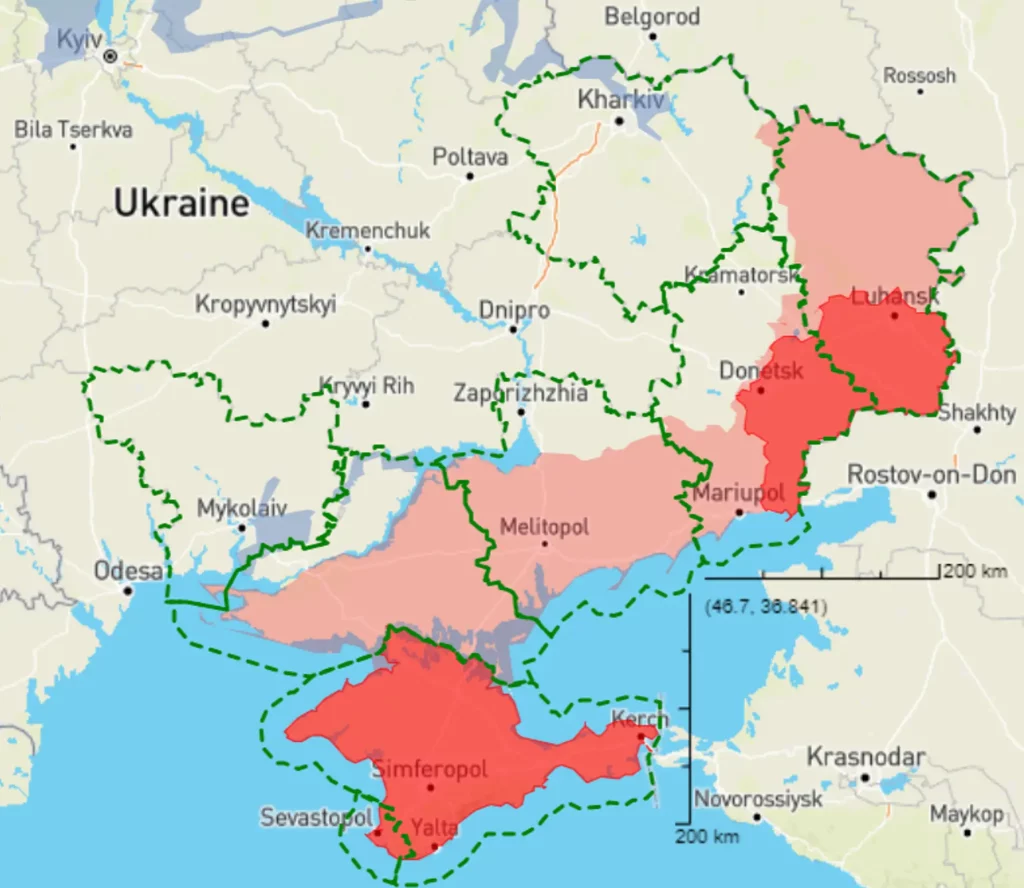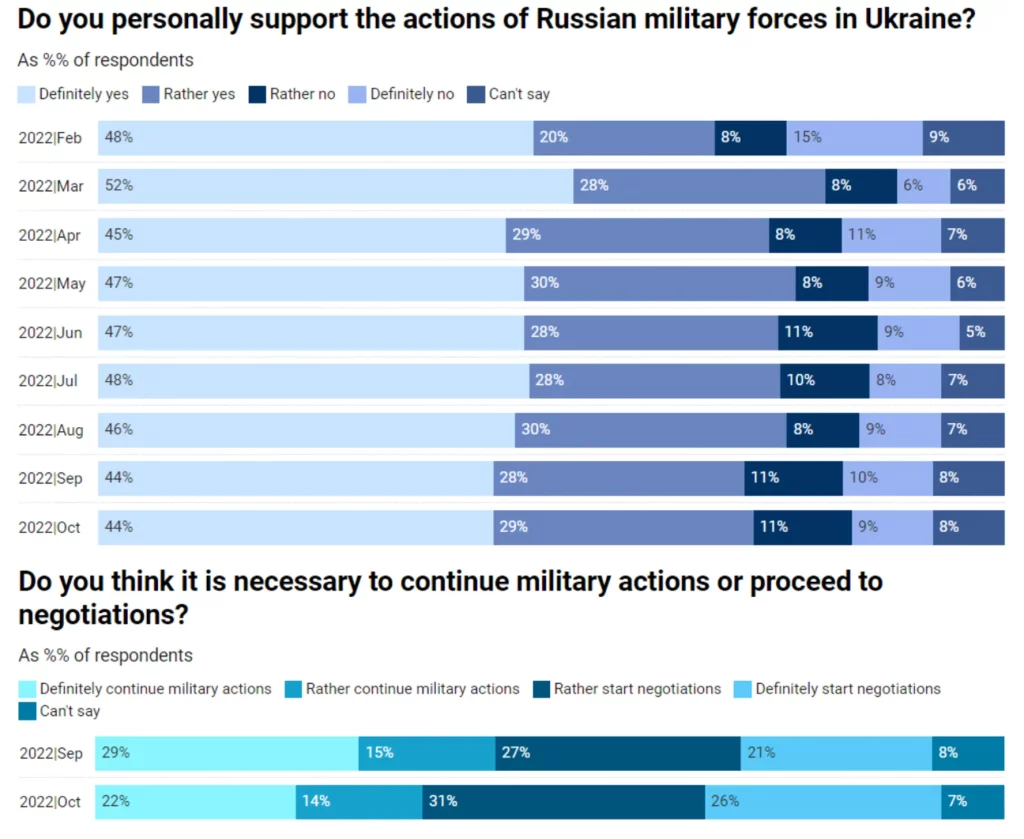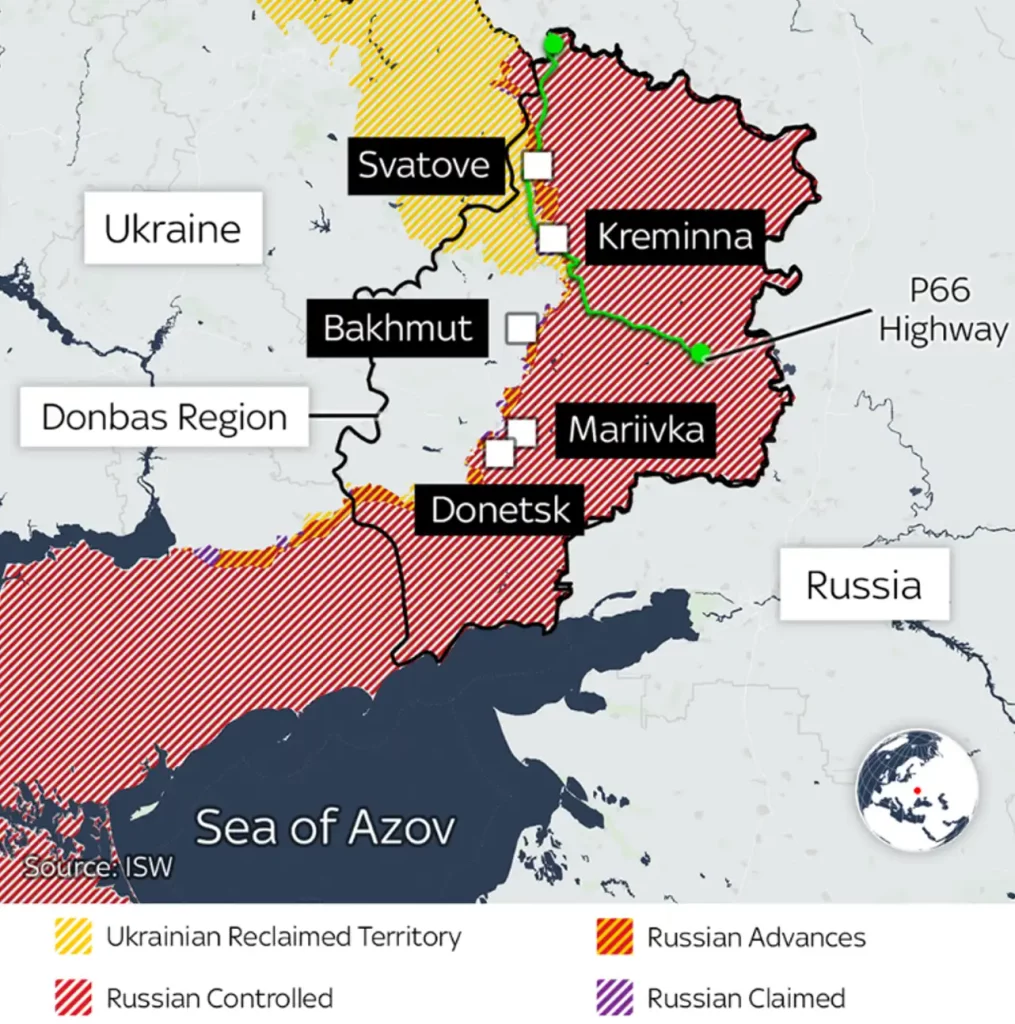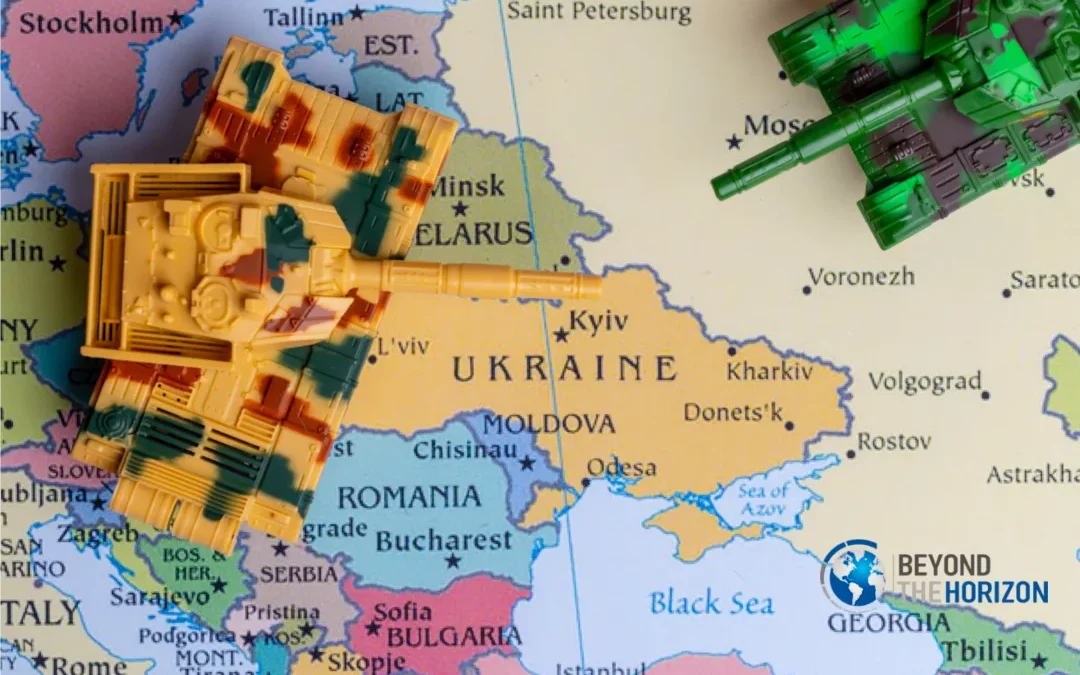1. Introduction
Ukraine has withheld Russian attacks for over ten months as of January 2023. Surprisingly, Ukrainian forces managed to reconquer over half of the territory it lost to Russia since the beginning of the invasion. However, approximately 20% of the country is still under Russian control (Zagorodnyuk, 2023). The strategic successes on the battlefield against an enemy superior in numbers have led several analysts to believe that Ukrainian forces might be able to liberate the rest of the country in the future (Ackerman, 2023). This paper outlines the potential directions this war will take in a decisive spring that will steer the further course of this conflict. It is safe to say that Ukraine’s battlefield successes heavily rely on the willingness of Western countries to continue their multibillion-dollar military and humanitarian assistance (Michaels, 2022).

Figure 1 Assessed Russian-occupied territories in Ukraine as of January 16, 2023. Retrieved from Beyond the Horizon ISSG (2023).
2. Potential conflict directions in spring 2023
a. A shift towards Russian victory
At the end of 2022, Russian forces began strengthening defensive positions along the frontline, except for the area around Bakhmut, where primarily the Russian Wagner Group is still on the offensive. Ukrainian successes around Kharkiv in the north and Kherson in the south forced Russian troops to defend the remaining territory under their control in Ukraine and reorganise their units to continue the war (Luxmoore, 2023). While the situation now might be more promising for Ukraine than a few months ago, Russia is still far from beaten.
Above all, Russia’s military size is still larger than Ukraine’s, and it can create even more favourable force ratios by choosing where to attack, whereas Ukraine must defend everywhere (DiMarco, 2022). The actual numbers are unknown due to secrecy and the participation of non-official military forces in the conflict but remain favourable for Russia. At the end of 2022, both sides suffered around 100.000 casualties (Matthews et al., 2022). The Russian military had to abandon its plan of a swift operation in Ukraine and changed the conflict into a war of attrition that it can ultimately win with its superior numbers, and if the West becomes tired of sufficiently supporting Ukraine (Posen, 2023). As Dettmer (2023) said, “While Moscow largely holds its battlefield destiny in its own hands, Kyiv’s fate rests in those of its Western allies” (para. 23).
Therefore, Russia began to increasingly attack civilian infrastructures to distract Ukrainian and Western resources from strengthening offensive capabilities and instead focus on defensive systems to shield the country against drone and missile strikes. This strategy is known as “Strategic Operation for the Destruction of Critically Important Targets”, in short SODCIT (Hamilton, 2022, para. 2). This strategy targets critical functions of society rather than military forces. Attacks focus on energy, food, water, and medicine supply. The goal is to make the war so expensive that Western countries reduce their support over time.
Most importantly, Russia still has numerical superiority in airpower, artillery systems, and mobile armoured units. Their numbers are crucial for conducting large-scale military operations. Since October 2022, Russia has garrisoned more units in Belarus and will probably launch a second mobilisation effort at the beginning of 2023. The potential opening of a new front in the north forces Ukraine to divide its troops, weakening its capabilities to launch a successful offensive early in 2023 (Rudnik, 2022).
While Ukraine must fight for external military assistance, it is difficult to achieve significant breakthroughs against a newly growing and entrenched Russian force that will strike again when the time has come (Sly, 2023). Ukrainian territorial progresses also mean that Russian troops are increasingly concentrated and have an easier time defending their controlled territory due to the shortened front. Thus, it becomes increasingly difficult for Ukraine to make territorial progress.
Another crucial indicator is that Russia learns during the conflict, and its decision-making becomes more rational in certain aspects. This behaviour is contrary to the strategic planning at the beginning of the war, which was a “disastrous miscalculation” (Goncharenko, 2022, para. 1). Instead, Russia’s strategy over the past months makes more sense from a military perspective. An exemption is the battle of Bakhmut, mainly fought by the Wagner Group. An example of the changing Russian behaviour is the shift to target Ukrainian infrastructure. This strategy maximises losses on the Ukrainian army and pressures it to focus on defence while minimising the casualties of Russian ground forces, sparing them, and waiting for fresh recruits to conduct offensive operations in the future (Hamilton, 2022).
Another case is the withdrawal from Kherson. This operation was a significant victory for Ukraine, but at the same time vital for Russia to save its experienced army units and continue the war. Observers pointed out that Ukraine missed the chance to inflict higher casualties on the Russian army. A discovered document outlining the Russian withdrawal schedule shows the presumable number of troops that Russia managed to rescue (Miller, 2023). Apparently, most of Russia’s airborne force defended Kherson, consisting of three divisions and three separate brigades, except for the 106th Guards Airborne Division, stationed in Belgorod (see Figure 1). These airborne troops, also known as VDVs, are well-experienced and can be described as the “Russian Army’s centre of gravity” (Miller, 2023, para. 5). Next to the airborne units were other Russian military formations. Together they had the size of two army-sized groupings and managed to escape Ukrainian forces with their equipment. Those were more than 30.000 soldiers. The careful advance of Ukrainian forces allowed Russia to save most of its troops in Kherson, which were redeployed and strengthen Russia’s line in more defensible terrain elsewhere. Ukraine missed the chance to attack vulnerable Russian troops despite intelligence reports of the troop withdrawal. Opportunities like these are rare (Lister & John, 2022).
Another indication for the Russian continuation of the war is a simple fact that Russia can continue the aggression. The country withstood economic sanctions better than expected. Despite some opposition to the conflict, it does not seem like the population is willing to act against its leadership. As Kirillova (2023) observed, years of propaganda have created a collectively altered consciousness, where most Russians have a moderate understanding of the truth but perceive the current circumstances as ordinary. So the situation is just accepted as it is. Due to the domestic state of affairs, President Putin can resume the conflict. Ukraine can only maintain its sovereignty through a military defeat because Russia will always demand Ukrainian territory in peace negotiations and attack again when its forces are rebuilt (Kirillova, 2023). One of the most recent surveys of Russian war support in October 2022 shows that more than 70% of Russians still support the actions of Russian military forces in Ukraine. So the majority of Russians endorse the war. However, the same survey revealed that more people are willing to start negotiations instead of continuing the conflict compared to October 2022 (Levada Center, 2022). The Russian non-governmental Levada Center is often considered one of the most reputable databases in Russia (Kizlova & Norris, 2022).

Figure 2 Russian support for the war and willingness to enter negotiations. Retrieved from Levada Center (2022).
The beginning of 2023 will undeniably have a decisive impact on the further course of the war. Russia will wait until the second half of its mobilisation effort is ready to join the fight. It is expectable that approximately 150.000 new Russian soldiers will finish their training in February. This rally means that a Russian offensive is expectable around February or March 2023, which is likely to occur around Bakhmut and perhaps another attack on Kyiv to divide Ukrainian troops (Moloney, 2022). At the same time, Russia will continue to attack Ukrainian infrastructure with relatively cheap means, such as drones, which are expensive to defend and further drain Western and Ukrainian resources. Russia’s main goal for 2023 is to fully control the four provinces Donetsk, Luhansk, Kherson, and Zaporizhia, which it annexed in October 2022, while also attacking Kyiv again. This control would put Russia in a favourable position for future negotiations and calm the Russian population. The success or failure of this scenario depends on the efficient use of Russia’s newly trained soldiers and the Western support for Ukraine.
b. A shift towards Ukrainian victory
The successful Ukrainian defence over the past ten months and reconquest of lost territory gives enough reason to believe that the country can achieve further military successes in spring 2023. The professionalism and morale of Ukrainian troops, together with Western support, have led to some remarkable victories. Furthermore, the conflict has shown that most Ukrainians, whether soldiers or civilians are willing to give everything to protect their country. This determination has crucial implications for the continuation of the war as it lessens the impact of Russian attacks on Ukrainian infrastructure, aiming at reducing morale and war support. On the contrary, Ukrainians are even more willing to defend their country, and Russia will not win the war if it cannot conquer all of Ukraine (Kirby, 2022).
As previously mentioned, Ukraine’s success heavily relies on Western support and will continue to do so. Especially the American HIMARS artillery system enabled Ukraine to hit key Russian positions, facilitating most of its battlefield successes (Mansoor, 2023). However, Ukraine received all kinds of essential weapon systems, both offensive and defensive. Furthermore, the international community dispatched enormous humanitarian assistance packages to protect the population and sustain the 2022/23 winter. Mainly EU member states and the U.S. provided the 100-billion-euro military and humanitarian assistance (Kiel IFW, 2022). Russia’s aggression is not only seen as an attack on Ukraine “but as an attack on the existing rules-based world order and as part of a broader conflict between liberal democracy and authoritarianism” (Olofsgård, 2022, para. 16). This explains the large amounts of foreign aid.
Even though Ukraine managed to destroy large amounts of Russian military equipment, it is undeniable that Ukraine lost a lot of its own equipment, which needs replacement to continue the war. According to Hooker (2022), the Ukrainian army needs support in mainly three categories: airpower, long-range artillery, and armoured mobility. Ukrainian forces are relatively successful in denying Russia air supremacy despite its smaller air force. However, Ukraine will need a strong air force to support offensive operations. The air support would reduce the losses of ground units while inflicting higher casualties on the Russian army. Secondly, Ukraine needs more long-range artillery to attack Russian supply routes and destroy logistic hubs or other high-value targets behind the front. These strikes would weaken Russian lines for future offensives. The reconquest of Kherson has already shown the strength of this tactic. Lastly, more armoured vehicles are needed to enable quick attacks, protect Ukrainian troops, and achieve local breakthroughs to throw back Russian troops to new defensive lines and push them out of the country. Without sufficient numbers of mobile armoured units, Ukraine must wage in a slower, more predictable, and trench-warfare style that is more costly and less effective (Hooker, 2022).

Figure 3 Map of Southern Ukraine. The two arrows show the potential Ukrainian spring offensive in 2023. Kherson is located in the west and Crimea in the south. Retrieved from Beyond the Horizon ISSG (2023).
Figure 3 shows the most probable offensive option that Ukraine could launch in spring 2023. An offensive towards Berdiansk and Melitopol would cut off crucial Russian supply lines towards Crimea and put high pressure on the Russian military. However, Russia already anticipated this attack and prepared defensive lines to counter such an offensive at the end of 2022 (Dellanna, 2023). Generally, Ukraine’s army is much better at sustaining the harsh winter conditions than the Russian army due to its equipment. Therefore, it is likely that Ukraine will still launch this offensive in winter when the ground is frozen, enabling major troop manoeuvres. Furthermore, Ukrainian troops are better positioned equipment-wise for the winter than Russia’s (Dellanna, 2023). However, it would not be a surprise if Ukraine decides to attack a different front and only wants to force Russian troops to the south. Ukraine has already effectively done this in Kherson and Kharkiv (Khurshudyan et al., 2022). The second-best option for Ukraine would be to reinforce its attack between Svatove and Kremina to take control of the P66 Highway. For Russia, this street is the main supply line from Belgorod to Kremina in the Luhansk region. This offensive could force Russian troops around 40 kilometres back and would be another success in the liberation of Ukrainian territory in the east (Ministry of Defence, 2023).

Figure 4 Location of the P66 Highway and the Svatove-Kremina frontline. Retrieved from Sky News (n.d.).
The supply of Ukraine with Western military equipment reached a new threshold debate at the end of 2022 and the beginning of 2023 when Western countries announced new forms of support. Firstly, the U.S. and Germany pronounced that they would provide Ukraine with the surface-to-air “Patriot” system, which allows Ukraine to intercept incoming Russian missiles (Brown et al., 2023). Secondly, the U.S., Germany, and France announced that they would send armoured vehicles to Ukraine, consisting of the AMX-10, Marders, and M2 Bradleys. Russia was furious about this decision and warned of another step toward escalation. These vehicles enable Ukraine to launch new offensives and are superior to their Soviet-era equivalents, often used on both sides of the conflict (Erlanger & Gibbons-Neff, 2023). Lastly, the United Kingdom declared it would supply Ukraine with 14 of its Challenger 2 battle tanks. So far, Western countries refrained from sending main battle tanks to Ukraine. They fear that they could lead to an escalation in the conflict and potentially the use of nuclear weapons as retaliation by Russia. However, the British decision has raised this discussion again. Maybe other governments will follow this example (Holden, 2023). The threshold debate is a balancing act between supplying Ukraine with the weapon systems it needs and an escalation of the conflict that could lead to a nuclear strike by Russia.
3. Western support in 2023
The high casualties on both sides and the challenging weather have shown that it is difficult for Russia and Ukraine to make any progress at the moment. Both countries prepare their troops for new offensives to get an advantage in the conflict. Russia waits until its new 150.000 soldiers finish their training in February, whereas Ukraine waits for more Western military equipment. Therefore, much of Ukraine’s success depends on Western support. The most crucial decision as of January 2023 is whether more countries are willing to join the British government in providing modern tanks to Ukraine. The offer by Great Britain is more of a symbolic gesture to convince its allies of this decision. This assurance is similar to France’s decision in December 2022 to send armoured vehicles to Ukraine, where the U.S. and Germany followed later (Allison, 2023).
There are two main arguments against supplying Ukraine with Western tanks. Firstly, the risk of further escalating the conflict, and secondly, the extensive supply system they require. For the former argument, Putin threatened several times that Russia adapts its full range of weapon systems based on international support. Consequently, Western countries were often hesitant about the types of weapons they sent to Ukraine (Davies, 2022). However, analysts such as Hooker (2022) believe that, while the threat is real, it is unlikely that Russia will use nuclear weapons as long as there is no substantial threat to the existence of the Russian state. This assumption originates from the nuclear deterrence regime existing since the 1950s. Furthermore, giving in to Putin’s demands would only show him that his strategy works and that he can further pursue it. In this view, appeasing Putin is more dangerous than opposing him.
For the second argument, critics stated that Ukraine is currently unable to maintain Western tanks. Therefore, it does not make sense to supply them at the moment. Sending the material, training the crews, and incorporating the units in Ukraine’s military will take a few months (Erlanger & Gibbons-Neff, 2023). Nonetheless, the Ukraine war has shown that Western countries are redefining their thresholds of weapon supply throughout the conflict. Thus, it should not come as a surprise if they send tanks or even fighter jets to Ukraine at some point. Despite the high costs for Ukraine’s allies, Dellanna (2023) argued that someone could make the cynical claim that the support is still a relatively low-cost solution for the West to face Russian aggression. Consequently, it is expectable that their support will only rise.
4. Implications of the conflict
The conflict can be interpreted as part of a broader struggle between authoritarianism and democracy. Other challenges of the current world order will analyse how far they can go based on the experience of the Ukraine War. One example is China and the growing tensions over Taiwan. Consequently, the current conflict will test to what extent the democratic order can resist these types of aggressions (Kirillova, 2023).
Overall, the Ukraine War manifests Russia’s objection to the entire post-1991 European settlement (Fukuyama, 2022). At the same time, Ukrainians have shown their willingness to defend their country as long as necessary. These inherently different war goals render a negotiated peace deal unlikely as both sides have different sovereign war aims and do not accept each other’s territorial ideas. Thus, it is more probable that a complete military success by either party over the adversary will decide the outcome of this conflict, at least until there is a political change in either one of these countries.
In case of a Ukrainian victory, the future of Russia-West relations will depend on the political leadership in Russia, whether it is the current government or a different one. In case of a Russian victory, the relationship will suffer for a long time, and it will take a while until there is some form of international convergence. Lastly, if there is a prolonged stalemate, any halt to military operations is only temporary. The fighting will continue as soon as one side feels to be in a better position (van der Togt, 2022). In conclusion, it is noteworthy that the whole assessment of this paper is mainly based on a generalised view between traditionally associated Western countries and Russia and does not necessarily reflect the implications or perception of the whole international community.
References
Ackerman, E. (2023, January 4). Ukraine’s winter offensive could decide the war. Time. https://time.com/
Allison, G. (2023, January 14). Britain confirms plans to give Challenger 2 tanks to Ukraine. UK Defence Journal. https://ukdefencejournal.org.uk/
Beyond the Horizon ISSG. (2023, January 16). Ukraine crisis horizon. https://behorizon.org/ukraine-crisis-horizon-2022/
Brown, D. Horton, J., & Ahmedzade, T. (2023, January 14). Ukraine weapons: What military equipment is the world giving? BBC. https://www.bbc.com/
Davies, A. (2022, December 7). Putin: Nuclear risk is rising, but we are not mad. BBC. https://www.bbc.com/news/world-europe-63893316
Dellanna, A. (2023, January 4). Ukraine “marshalling” troops for next major offensive: Here’s when and where Kyiv could strike. Euronews. https://www.euronews.com/
DiMarco, L. (2022, June 20). Urban operations in Ukraine: Size, ratios, and the principles of war. Modern War Institute. https://mwi.usma.edu/
Erlanger, S., & Gibbons-Neff, T. (2023, January 6). New armoured vehicles will help Ukraine take the fight to Russia. The New York Times. https://www.nytimes.com/
Fukuyama, F. (2022, September). Why Ukraine will win. Journal of Democracy. https://www.journalofdemocracy.org/why-ukraine-will-win/
Goncharenko, R. (2022, December 26). Russia’s Ukraine war based on a “disastrous miscalculation”. Deutsche Welle. https://www.dw.com/en/
Hamilton, D.S. (2022, December 8). Forward resilience: How to help Ukraine win on and off the battlefield. Brookings. https://www.brookings.edu/
Holden, M. (2023, January 15). Britain to send 14 of its main battle tanks, more weaponry to Ukraine. Reuters. https://www.reuters.com/
Hooker, R.D. (2022, August 21). What Ukraine needs to win the war. Atlantic Council. https://www.atlanticcouncil.org/blogs/ukrainealert/what-ukraine-needs-to-win-the-war/
Khurshudyan, I., Sonne, P., Morgunov, S., & Hrabchuk, K. (2022, December 29). Inside the Ukrainian counteroffensive that shocked Putin and reshaped the war. The Washington Post. https://www.washingtonpost.com/
Kiel IFW. (2022, December 7). Ukraine support tracker: A database of military, financial and humanitarian aid to Ukraine. https://www.ifw-kiel.de/topics/war-against-ukraine/ukraine-support-tracker/
Kirby, P. (2022, November 16). Why did Russia invade Ukraine and has Putin’s war failed? BBC. https://www.bbc.com/news/world-europe-56720589
Kirillova, K. (2023, January 4). Ukraine – What will 2023 bring? CEPA. https://cepa.org/article/ukraine-what-will-2023-bring/
Kizlova, K., & Norris, P. (2022, March 17). What do ordinary Russians really think about the war in Ukraine? LSE. https://blogs.lse.ac.uk/europpblog/
Levada-Center. (2022, October). Conflict with Ukraine. https://www.levada.ru/en/
Lister, T., & John, T. (2022, November 11). Russia’s withdrawal from Kherson is a humiliating setback. Here’s what it means for the war. CNN. https://edition.cnn.com/.
Luxmoore, M. (2023, January 10). Russia gains ground in East Ukraine as fight for Bakhmut intensifies. The Wall Street Journal. https://www.wsj.com/
Mansoor, S. (2023, January 5). Why U.S. HIMARS rockets are becoming increasingly decisive for Ukraine. TIME. https://time.com/6244479/himars-rockets-ukraine-russia/
Matthews, A.L., Stiles, M., Nagorsji, T., Rood, J., & Labbate, M. (2022, November 17). The Ukraine war in data: More than 100.000 Russian casualties – and almost as many on the Ukrainian side. Grid. https://www.grid.news/
Michaels, D. (2022, December 11). Ukraine can win the war: But the cost may be too high for the West. The Wall Street Journal. https://www.wsj.com/
Miller, S. (2023, January 6). Russia’s withdrawal from Kherson. Wavell Room. https://wavellroom.com/
Ministry of Defence. (2023, January 2). Update on Ukraine. Twitter. https://twitter.com/DefenceHQ/status/1609797305850335233
Moloney, M. (2022, December 16). Ukraine war: Kyiv says Russia planning major ground offensive in new year. BBC. https://www.bbc.com/news/world-europe-63995244
Olofsgård, A. (2022, September 19). Foreign aid to Ukraine: Lessons from the literature on strategic foreign aid. Free Network. https://freepolicybriefs.org/2022/09/19/foreign-aid-ukraine/
Posen, B.R. (2023, January 4). Russia’s rebound: How Moscow has partly recovered from its military setbacks. Foreign Affairs. https://www.foreignaffairs.com/
Rudnik, A. (2022, December 22). Will Putin force Belarus to join the Russian invasion of Ukraine? Atlantic Council. https://www.atlanticcouncil.org/
Sky News (n.d.). Ukraine war – latest. https://news.sky.com/?
Sly, L. (2023, January 9). Ukraine sees “year of victory” but Russia has other plans. The Washington Post. https://www.washingtonpost.com/world/2023/01/08/ukraine-war-2023-russia-future/
van der Togt, T. (2022, December 9). Three scenarios for the future of Russia-West relations. Clingendael Institute. https://www.clingendael.org/publication/three-scenarios-future-russia-west-relations
Zagorodnyuk, A. (2023, January 2). The case for taking Crimea: Why Ukraine can – and should – liberate the province. Foreign Affairs. https://www.foreignaffairs.com/ukraine/case-taking-crimea

